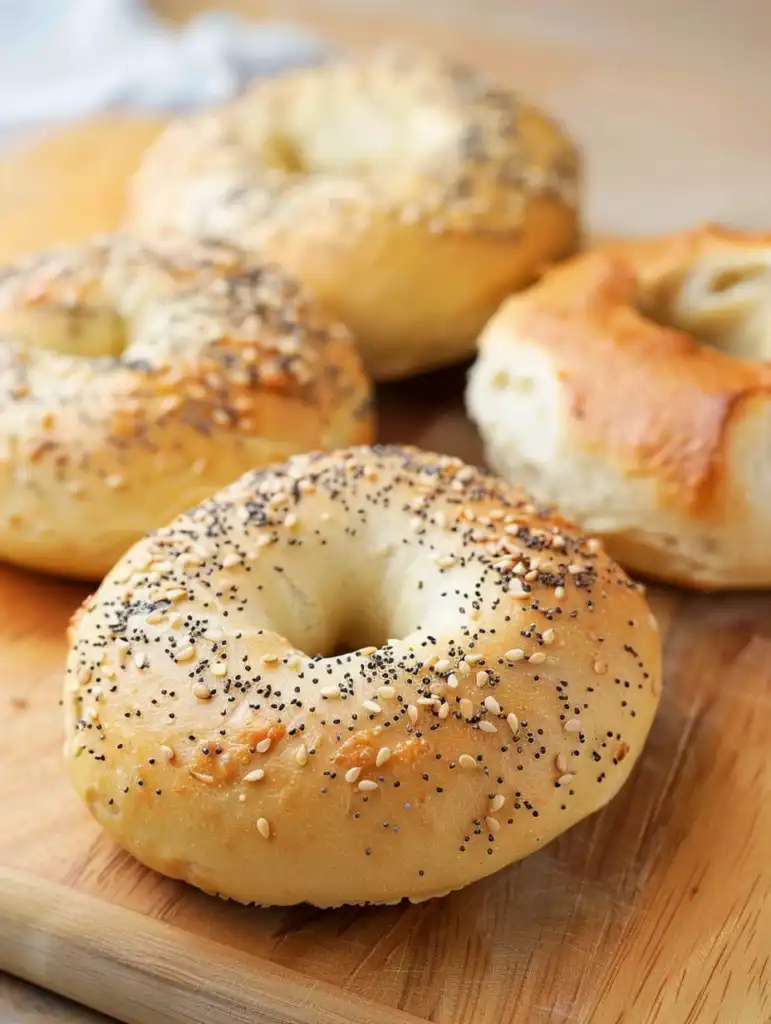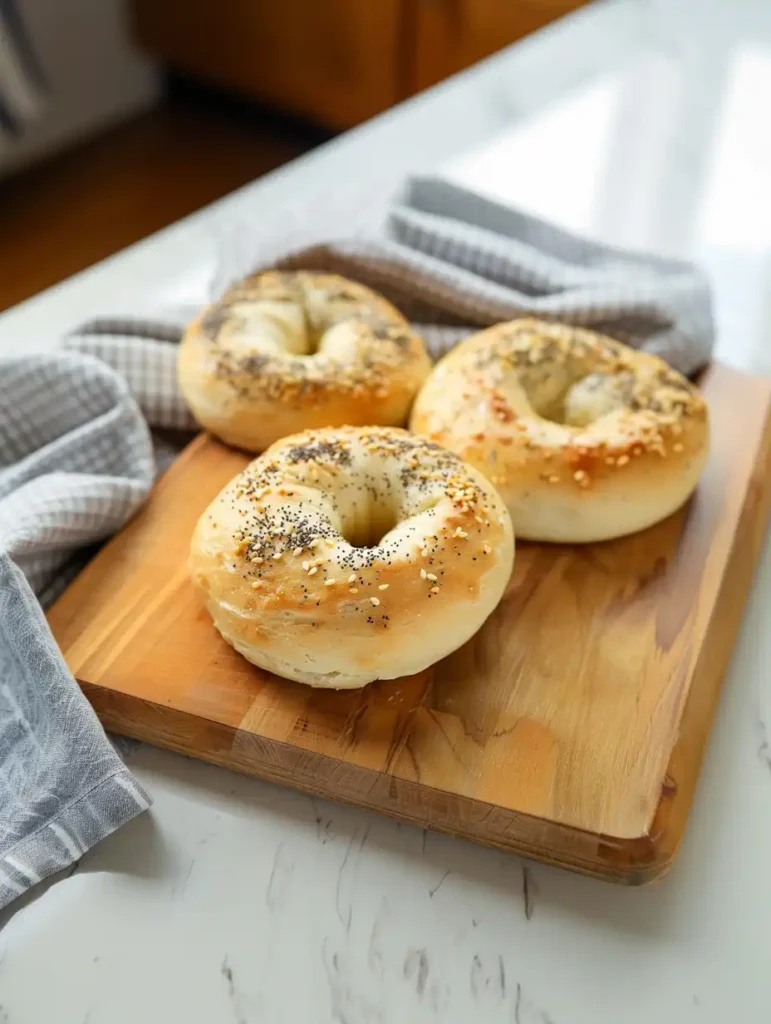I never thought I’d find myself craving bagels after starting keto. The first few weeks were tough – walking past the bakery section at the grocery store felt like torture.
Then I discovered these cottage cheese bagels, and honestly, they changed everything. They’re not exactly like regular bagels (let’s be real here), but they definitely hit the spot when you want something bread-like that won’t kick you out of ketosis. After a few tries in my kitchen, I figured out the right way to make them, and now they’re a weekend breakfast staple at my house.
Why You’ll Love These Keto Bagels
- Keto-friendly breakfast – With almond flour and cottage cheese as the base, these bagels fit perfectly into a low-carb lifestyle while still giving you that satisfying bagel experience.
- High in protein – Thanks to the cottage cheese and eggs, each bagel packs a protein punch that will keep you feeling full throughout the morning.
- Quick preparation – You can have fresh, homemade bagels ready in just 45 minutes – much faster than traditional bagel recipes that require proofing and boiling.
- Basic ingredients – Most of these ingredients are common keto pantry staples, and you won’t need any special equipment or complicated techniques to make them.
- Customizable toppings – Whether you go for everything bagel seasoning or create your own blend, you can easily adjust the toppings to match your taste preferences.
What Kind of Cottage Cheese Should I Use?
For keto bagels, you’ll want to stick with full-fat cottage cheese since it provides better structure and helps create that authentic bagel texture.
Small or medium curd varieties are your best bet here, as they blend more smoothly with the almond flour mixture – though large curd will work too if you mash it up well first.
If you’re counting carbs carefully, double-check the label since some brands add more milk products or stabilizers that can increase the carb count.
A quick tip: draining excess liquid from your cottage cheese before measuring can help prevent your bagel dough from becoming too wet, which is especially important when working with almond flour.
Options for Substitutions
Following a keto diet means being careful with substitutions, but here are some tested swaps that work well in this recipe:
- Almond flour: This is a key ingredient for the keto aspect, but you can use sunflower seed flour in a 1:1 ratio if you have nut allergies. Note that sunflower seed flour might turn slightly green when baked (don’t worry – it’s safe to eat!).
- Cottage cheese: You can swap this with full-fat ricotta cheese or cream cheese. If using cream cheese, make sure it’s softened and reduce the melted butter to 3 tablespoons.
- Coconut flour: This is tricky to substitute since it’s very absorbent. If needed, you can use 1/3 cup extra almond flour, but your bagels might be less firm.
- Apple cider vinegar: Regular white vinegar or lemon juice work just fine here – they help activate the baking soda.
- Everything bagel seasoning: Making your own is simple – mix equal parts poppy seeds, sesame seeds, dried garlic, dried onion, and a pinch of salt. Or try other toppings like shredded cheese or just sea salt.
- Eggs: The eggs are necessary for structure in this recipe and can’t be substituted while keeping the recipe keto-friendly.
Watch Out for These Mistakes While Baking
The biggest challenge when making keto bagels is achieving the right dough consistency – if your mixture is too wet, you’ll end up with flat, pancake-like shapes instead of proper bagels, so start by thoroughly draining your cottage cheese and adding coconut flour gradually until you reach a workable consistency.
When shaping your bagels, wet hands are your best friend – the dough can be sticky, but instead of adding more flour (which can make them dense), simply keep your hands slightly damp while forming the rings.
For the best texture, don’t skip the apple cider vinegar as it reacts with the baking soda to create air pockets, and make sure to let the bagels cool completely on a wire rack before slicing, otherwise they might become gummy in the middle.
Storage Instructions
Keep Fresh: These keto bagels stay good in the fridge for about 5 days when kept in an airtight container. I like to slice them before storing – it makes it super convenient to grab and toast whenever I want one. Just place a piece of parchment paper between the slices to prevent them from sticking together.
Freeze: Want to make a big batch? These bagels freeze really well! After they’ve cooled completely, pop them in a freezer bag or container and they’ll keep for up to 3 months. I usually slice them before freezing so I can take out just what I need.
Toast: When you’re ready to eat a stored bagel, just pop it in the toaster straight from the fridge. If it’s frozen, no need to thaw first – just add an extra minute to the toasting time. They toast up perfectly and taste almost as good as fresh-baked!
How to Know When the Cottage Cheese Bagels are Done
Keep an eye on your bagels as they bake – they should turn a nice golden brown color on top and feel firm to the touch when they’re ready, which typically takes about 20-25 minutes.
To double-check doneness, gently tap the bottom of a bagel – it should sound hollow and feel light, not dense or heavy.
If you’re still unsure, you can insert a toothpick into the thickest part of the bagel – it should come out clean without any wet dough sticking to it.
Let them cool on a wire rack for about 10 minutes before slicing, as they’ll continue to firm up during this time.
Keto Cottage Cheese Bagels FAQ
Why does this recipe use apple cider vinegar?
The apple cider vinegar plays an important role in these bagels by reacting with the baking soda to help them rise properly. When these two ingredients combine, they create bubbles that give the bagels a lighter, more bread-like texture. Without it, your bagels might end up dense and flat.
Do I need to drain the cottage cheese before using it?
Yes, it’s best to drain any excess liquid from your cottage cheese before mixing it into the dough. I usually place it in a fine-mesh strainer for about 10 minutes to let the liquid drain out. This helps prevent your dough from becoming too wet, which could affect the final texture of your bagels.
Why are my bagels cracking on top while baking?
Small cracks on top are actually normal for these keto bagels! The almond flour and eggs create a different structure than traditional wheat flour, so some cracking is expected. As long as your bagels hold together well, those little cracks are just part of their homemade charm and won’t affect the taste at all.
Estimated Nutrition Facts
Estimated nutrition for the whole recipe (without optional ingredients):
- Calories: 1500-1600
- Protein: 113–114 g
- Fat: 100-110 g
- Carbohydrates: 40-50 g
| Preparation Time | 10-15 minutes |
| Cooking Time | 25-30 minutes |
| Total Time | 35-45 minutes |
| Level of Difficulty | Easy |
| Servings | 6 |
| Equipment | mixing bowl, donut pan |
Ingredients
- 2 cups almond flour
- 1 cup cottage cheese
- 4 tablespoons coconut flour
- 2 tablespoons apple cider vinegar
- 1 teaspoon baking soda
- 1/4 cup melted butter
- 5 eggs
- Everything but the bagel spice seasoning or else, simply do a mix of black and white sesame seeds, diced/minced or dried garlic, dried onions
Step 1: Blend the Ingredients
Begin by placing all your ingredients (except for the Everything But the Bagel seasoning) into a food processor.
Blend until everything is well combined and the mixture is smooth.
This step is crucial for ensuring an even texture in your bagels.
Step 2: Let the Batter Rest
Once blended, allow the mixture to sit for about 5 minutes.
This resting period helps the batter to thicken slightly, which is the desired consistency for shaping the bagels.
Step 3: Prepare the Donut Pan
While the batter is resting, prepare your donut pan.
Grease it generously with butter to prevent sticking.
Alternatively, you can use a silicone mold, which makes removal much easier.
After greasing, spoon the batter into the well-prepared donut pan, filling each cavity evenly.
Sprinkle your Everything But the Bagel seasoning or any preferred seasonings atop each bagel.
Step 4: Bake the Bagels
Preheat your oven to 350°F (175°C) and bake the bagels for 25-30 minutes.
Keep an eye on them as they bake; they should turn a nice golden color when done.
Step 5: Cool and Remove from the Pan
Once baked, allow the bagels to cool completely in the pan.
If you used a non-silicone mold, you might need to gently carve around the edges with a knife and carefully lift each bagel out.
If you used a silicone mold, they should pop out easily.
Step 6: Store the Bagels
To store your bagels, keep them in the refrigerator for up to a week, or place them in an airtight container in the freezer for longer storage.
Enjoy your homemade bagels whenever the craving strikes!





How many does the recipe make?
Around 4-6 Bagels depends on the Size.
these are delicious! I even put them in my waffle maker and they make great waffles!
What can I replace the butter with?
Your recipe intrigued me, and since I miss bagels and breads because I’m following semi-keto diet (significant reduction in carbs)I thought I’d give it a try. SImplicity, thy name is Easy Cottage Cheese Almond Flour Bagels! They’re more cakey than bready, but toasted, they’re great.
A couple of take aways:
– I have silicone donut trays measuring 4″ per mold. You suggest the recipe makes 4 to 6. The magic number when I make them again will be 6. I overloaded with 4 and they flowed out of the mold.
– It was much easier to pipe the dough rather than spoon into the molds.
All in all, a winning recipe!
What’s the nutritional content?
My carbmanager app shows this for 6 bagels. 5 net carbs 15g protein 26g fat 342 calories
I made these in a muffin pan and it made 6 full sized large muffins. While the final result wasn’t like the pictures in texture, the flavor and texture was delish! My dough was very soft but Ill definitely make these as plain muffins again. Cut in half and warmed up, they were tender & moist. Thanks for sharing!
Is there a substitute for the coconut flour? I’m allergic to coconut.
A print feature would be most helpful.